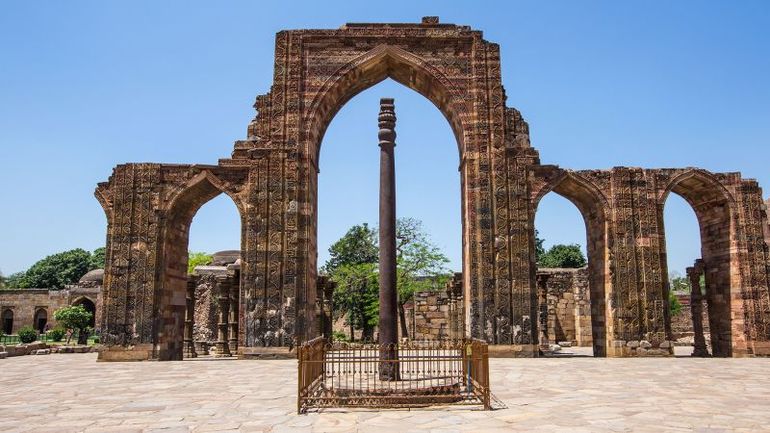
Unveiling the Enigma: The Untarnished Iron Pillar of India Standing Strong for Centuries

The Iron Pillar in New Delhi has captivated the curiosity of researchers worldwide for generations. In 2003, a breakthrough in metallurgy finally unraveled the secret behind its remarkable resistance to rust.
Is it possible for an iron structure to remain standing for 1,600 years without rusting, even when constantly exposed to the elements? One might find it hard to believe, especially given the limited technology available during its construction.
Inside the UNESCO-listed Qutb Minar complex in New Delhi, a collection of historic monuments and buildings from the early 13th century, there is a mysterious structure that captures the imagination.
In the courtyard of the Quwwat-ul-Islam Mosque within the complex, visitors will come across an impressive 7.2-meter, six-ton iron pillar with a decorative top that predates the entire complex.
The pillar, dating back to the 5th century, stands as pristine now as it did when it was first forged. It has managed to withstand the test of time, braving environmental challenges such as the intense temperatures and pollution in the Indian capital. This remarkable resilience never fails to fascinate travelers who come across it. But how exactly has it managed to defy corrosion for so many centuries?
The Quwwat-ul-Islam mosque is part of the UNESCO-listed Qutb Minar complex.
The Quwwat-ul-Islam mosque is part of the UNESCO-listed Qutb Minar complex.
Iron and iron alloy structures usually rust over time when exposed to air or moisture. However, some, like the Eiffel Tower, are protected with special paint to prevent this. In 1912, scientists from India and abroad started studying the iron pillar in Delhi to understand why it had not corroded.
In 2003, experts at the Indian Institute of Technology (IIT) in Kanpur finally solved the mystery of the iron pillar. They published their findings in the journal Current Science.
The pillar, mainly composed of wrought iron, contains a high amount of phosphorus (around 1%) and does not have sulfur or magnesium like modern iron. The ancient craftsmen also utilized a method known as "forge-welding" in creating the pillar.
They heated and hammered the iron, while still preserving the high phosphorus content, which is not typically done in modern methods.
According to archeo-metallurgist R. Balasubramaniam, this unique technique played a significant role in maintaining the pillar's strength over time.
Sonamarg,India - August 15 2017 : Trekkers Hike along the beautiful Kishansar lake on the Kashmir Great Lakes trek in Sonamarg, India. Most serene trek in the Himalayas with glacial lakes & valleys
Trekkers are seen hiking along the stunning Kishansar lake on the Kashmir Great Lakes trek in Sonamarg, India. This trek is known for its serene beauty, featuring glacial lakes and valleys nestled in the Himalayas.
Vivek_Renukaprasad/iStock Editorial/Getty Images
Related article
India is a paradise for hikers, offering a wide variety of epic trails to explore.
A scientist discovered a thin layer of “misawite” on the surface of a pillar in India. This compound, made of iron, oxygen, and hydrogen, is formed when there is high phosphorus in the iron and no lime present. This layer enhances the durability of the pillar.
Balasubramaniam praised the metallurgists for their cleverness, calling the pillar a "living proof of India's ancient skills in metalworking."
The pillar's strength can be seen in historical records, like an event in the 18th century where a cannonball shot at it didn't even leave a dent, highlighting the remarkable durability of this old monument.
Today, the pillar serves as the emblem of scientific organizations like the National Metallurgical Laboratory and the Indian Institute of Metals.
Myths and legends surround pillar’s origin
A closeup of the inscription on the Iron Pillar.
A closeup of the inscription on the Iron Pillar.
The Iron Pillar is not only interesting for its metallurgical aspects but also shrouded in mystery. According to a popular belief, it dates back to the Gupta Empire, specifically during the rule of Chandragupta II, also known as Vikramaditya, in the 4th and 5th centuries.
According to this tale, the pillar was erected in the Varah Temple of Udayagiri Caves, near Vidisha in Madhya Pradesh, as a victory monument dedicated to the Hindu deity Lord Vishnu. It’s said to have once borne a statue of Garuda, the mythical eagle mount of Vishnu, on its top, though this figure has been lost to history.
Another theory, proposed by heritage activist and educator Vikramjit Singh Rooprai, suggests it may have been bought by Varāhamihira, a renowned astronomer in the court of King Vikramaditya.
Vikramjit mentions that one of his books, the ‘Surya Siddhanta,’ explains how to calculate celestial positions, eclipses, and other astronomical events. It is believed that he used a tall pillar in his calculations.
Therefore, when he moved from Vidisha to Mihirapuri (now Mehrauli) and established an observatory, it is possible that he brought the pillar along to continue using it for his studies and calculations.
Asafoetida flower with lady bird on it.
Asafoetida flower with lady bird on it.
Adobe Stock
Related article
Hing, also known as devil's dung, is a highly controversial ingredient in Indian cuisine. It has sparked debates among food enthusiasts, with some loving its unique flavor and aroma, while others find it repulsive.
Historical records suggest that notable figures like Raja Anangpal of the Tomar dynasty, as well as Muslim rulers such as Iltutmish and Qutbuddin Aibek, played a role in relocating the pillar to the Qutb complex.
The Iron Pillar has also been referenced in the arts. In the epic poem "Prithviraj Raso" written by Chand Bardai, a courtier in the Chahamana dynasty under King Prithviraj Chauhan, the Iron Pillar is depicted with great importance.
Vikramjit explains that Bardai describes the Iron Pillar in Raso as a nail holding the Earth on the hoof of Sheshnag, the serpent king in Hindu mythology.
Raso tells the story of Raja Anangpal attempting to remove a nail despite warnings from Brahmins about the consequences. When the nail was pulled out, a red base resembling Sheshnag's blood was revealed, causing panic over the fear of Earth's destruction. Anangpal quickly ordered the nail to be reinstalled, but it was not properly secured, leading to it becoming loose. This incident is believed to have inspired the colloquial name 'Dilli' for Delhi, a play on the Hindi word 'dhilli' meaning 'loose'.
Efforts to preserve the cultural significance of this story are ongoing. The tale of the nail and its connection to Delhi's name are being passed down through generations. Various initiatives are being undertaken to ensure that this important piece of history is not forgotten. By preserving and sharing such stories, the rich cultural heritage of Delhi is being celebrated and cherished.
The Qutub Minar complex is named after this red sandstone tower.
The Qutub Minar complex is named after this red sandstone tower.
Legend has it that if you stand with your back against the pillar and wrap your arms around it, ensuring your fingers touch, your wish will be granted. This tradition adds a spiritual meaning to the pillar, going beyond just its historical importance.
The ASI has erected a fence around the pillar to reduce human impact. Conservation architect and heritage expert, Pragya Nagar, admires the impressive preservation of the pillar within the complex, despite the changes in its surroundings due to demolition and reconstruction over time.
"If we shift our perspective on the technique used to create the pillar, we can explore ways to use similar methods for sustainable material alternatives. This is important because processes like metal extraction can harm the environment," she explains to CNN.
"It's crucial to see history not just as relics to be preserved and admired, but as sources of traditional knowledge and indigenous practices. Taking this comprehensive approach could lead us to a more sustainable future."
Editor's P/S:
The Iron Pillar of Delhi is a testament to the ingenuity and craftsmanship of ancient Indian metallurgists. Its remarkable resistance to corrosion over centuries is a testament to their mastery of metallurgy. The pillar's unique composition and construction techniques, such as forge-welding and the presence of high phosphorus content, have contributed to its exceptional durability.
The pillar's historical and cultural significance only adds to its allure. Its association with the Gupta Empire and its potential role in astronomical calculations further enhances its mystique. The various legends and traditions surrounding the pillar add a spiritual dimension to its existence, making it a revered object of cultural heritage. Preserving and promoting the knowledge and techniques used in creating the Iron Pillar can inspire sustainable material alternatives and foster a deeper appreciation for the wisdom of our ancestors.











